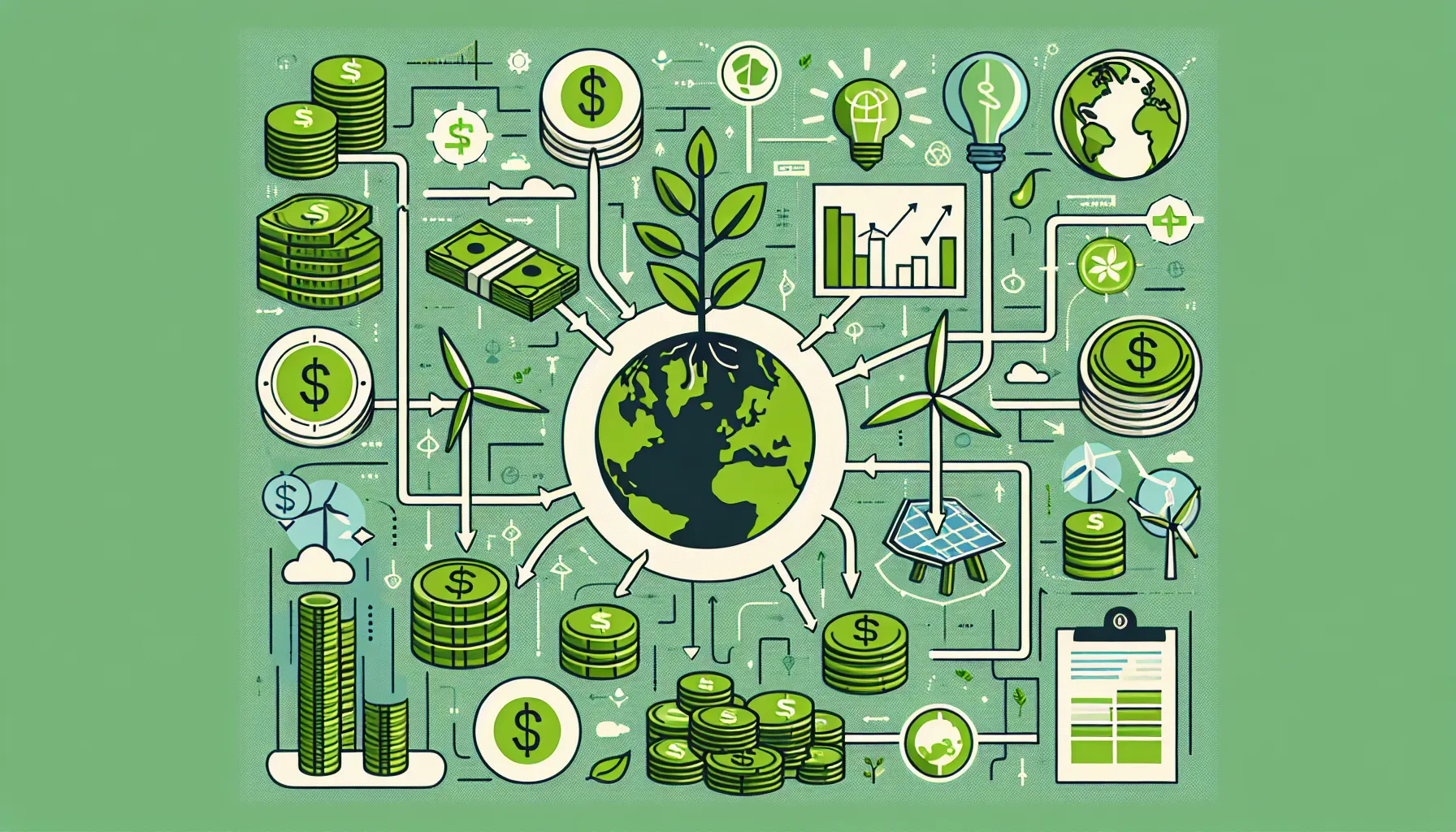Welcome to our IELTS Reading practice test focusing on “The Rise of Green Finance in Combating Climate Change.” This test is designed to help you prepare for the IELTS Reading section while exploring an important contemporary topic. Let’s dive into the world of green finance and its role in addressing climate change!
Nội dung bài viết
- Introduction to the Test
- Passage 1 (Easy Text)
- The Basics of Green Finance
- Questions 1-5
- Questions 6-10
- Passage 2 (Medium Text)
- The Impact of Green Finance on Climate Change Mitigation
- Questions 11-14
- Questions 15-19
- Question 20
- Passage 3 (Hard Text)
- The Evolving Landscape of Green Finance: Challenges and Opportunities
- Questions 21-26
- Questions 27-32
- Questions 33-35
- Answer Key
- Passage 1
- Passage 2
- Passage 3
 Green finance and climate change
Green finance and climate change
Introduction to the Test
This practice test consists of three passages of increasing difficulty, followed by a variety of question types typically found in the IELTS Reading exam. The passages cover different aspects of green finance and its impact on climate change mitigation efforts. Remember to manage your time wisely, as you would in the actual test.
Passage 1 (Easy Text)
The Basics of Green Finance
Green finance is a rapidly growing sector that aims to support environmentally friendly projects and initiatives. It involves the use of financial instruments and investment strategies to promote sustainable development and combat climate change. The rise of green finance has been driven by increasing awareness of environmental issues and the urgent need to transition to a low-carbon economy.
One of the key components of green finance is green bonds. These are fixed-income securities specifically earmarked to raise money for climate and environmental projects. Since the first green bond was issued by the World Bank in 2008, the market has grown exponentially. In 2020, global green bond issuance reached a record $269.5 billion, despite the economic challenges posed by the COVID-19 pandemic.
Another important aspect of green finance is sustainable investing. This approach considers environmental, social, and governance (ESG) factors alongside financial returns when making investment decisions. Sustainable investing has gained significant traction in recent years, with assets under management in ESG funds surpassing $1 trillion globally in 2020.
Green finance also encompasses other innovative financial products, such as green loans, sustainability-linked bonds, and carbon credits. These instruments provide businesses and governments with the means to fund projects that contribute to climate change mitigation and adaptation.
The rise of green finance has been supported by various international initiatives and agreements. The Paris Agreement, signed in 2015, set ambitious targets for reducing greenhouse gas emissions and limiting global temperature rise. This agreement has spurred governments and financial institutions to increase their focus on sustainable finance and climate-related investments.
As the world grapples with the challenges of climate change, green finance is expected to play an increasingly important role in mobilizing capital for environmental projects and driving the transition to a more sustainable global economy.
Questions 1-5
Do the following statements agree with the information given in the passage?
Write:
TRUE if the statement agrees with the information
FALSE if the statement contradicts the information
NOT GIVEN if there is no information on this
- Green finance only includes green bonds and sustainable investing.
- The World Bank issued the first green bond in 2008.
- Global green bond issuance decreased in 2020 due to the COVID-19 pandemic.
- Sustainable investing considers environmental factors but not social or governance factors.
- The Paris Agreement was signed in 2016.
Questions 6-10
Complete the sentences below.
Choose NO MORE THAN THREE WORDS from the passage for each answer.
- Green finance aims to support __ projects and initiatives.
- The market for green bonds has grown __ since 2008.
- In 2020, assets under management in ESG funds exceeded __.
- Green finance provides businesses and governments with the means to fund projects that contribute to climate change __ and adaptation.
- Green finance is expected to play an important role in mobilizing capital and driving the transition to a more __ global economy.
Passage 2 (Medium Text)
The Impact of Green Finance on Climate Change Mitigation
The escalating threat of climate change has propelled green finance to the forefront of global efforts to transition towards a sustainable, low-carbon economy. As governments, businesses, and financial institutions increasingly recognize the urgency of addressing climate-related risks, green finance has emerged as a powerful tool for channeling capital into projects and initiatives that support climate change mitigation and adaptation.
One of the most significant impacts of green finance on climate change mitigation is its role in accelerating the shift towards renewable energy. Renewable energy projects, such as solar farms, wind turbines, and hydroelectric facilities, require substantial upfront investments. Green bonds and other sustainable financial instruments have proven instrumental in mobilizing the necessary capital for these projects. For instance, the International Renewable Energy Agency (IRENA) reports that global investment in renewable energy capacity reached $303.5 billion in 2020, with a significant portion of this funding facilitated through green finance mechanisms.
Green finance has also been pivotal in promoting energy efficiency across various sectors. Energy-efficient buildings, which consume less energy for heating, cooling, and lighting, are increasingly being financed through green loans and mortgages. These financial products often offer preferential terms to borrowers who meet specific energy efficiency criteria, thereby incentivizing the construction and renovation of buildings with reduced carbon footprints.
Moreover, green finance has catalyzed innovation in climate-friendly technologies. By providing funding for research and development in areas such as carbon capture and storage, advanced battery technologies, and smart grid systems, green finance is helping to accelerate the development and deployment of solutions crucial for achieving global climate goals. The Global Commission on the Economy and Climate estimates that $90 trillion in infrastructure investments will be needed by 2030 to achieve a low-carbon, climate-resilient future, highlighting the critical role of green finance in funding technological advancements.
The impact of green finance extends beyond direct funding for climate-related projects. It has also influenced corporate behavior and decision-making processes. The growing emphasis on Environmental, Social, and Governance (ESG) criteria in investment decisions has prompted companies to improve their sustainability practices and disclosure. This shift has led to increased transparency in corporate climate-related risks and opportunities, enabling investors to make more informed decisions and encouraging businesses to adopt more sustainable practices.
Furthermore, green finance has facilitated the development of innovative financial products that align economic incentives with environmental outcomes. Sustainability-linked bonds, for example, tie the interest rate or other financial terms to the issuer’s achievement of specific sustainability targets. This mechanism creates a direct financial incentive for companies to improve their environmental performance, thereby contributing to climate change mitigation efforts.
The rise of green finance has also influenced policy-making and regulatory frameworks. Many countries have introduced guidelines and regulations to support the growth of green finance markets and ensure the integrity of green financial products. For instance, the European Union’s Sustainable Finance Action Plan aims to reorient capital flows towards sustainable investment, manage financial risks stemming from climate change, and foster transparency and long-termism in financial and economic activity.
While the impact of green finance on climate change mitigation has been substantial, challenges remain. Ensuring the credibility and effectiveness of green financial products, addressing the risk of “greenwashing,” and scaling up green finance to meet the enormous funding needs for global climate action are ongoing concerns. Nevertheless, the continued growth and evolution of green finance offer promising avenues for addressing the climate crisis and transitioning to a more sustainable global economy.
Questions 11-14
Choose the correct letter, A, B, C, or D.
-
According to the passage, green finance has had a significant impact on:
A) Reducing global temperatures
B) Accelerating the shift towards renewable energy
C) Eliminating the use of fossil fuels
D) Decreasing energy consumption in all sectors -
The passage suggests that green finance has influenced corporate behavior by:
A) Forcing companies to stop all environmentally harmful practices
B) Encouraging transparency in climate-related risks and opportunities
C) Requiring all companies to issue green bonds
D) Eliminating the need for traditional financial products -
Sustainability-linked bonds are described in the passage as:
A) A type of government regulation
B) A financial product that aligns economic incentives with environmental outcomes
C) A replacement for traditional bonds
D) A tool exclusively used for renewable energy projects -
The European Union’s Sustainable Finance Action Plan aims to:
A) Replace all traditional finance with green finance
B) Eliminate climate change risks in the financial sector
C) Reorient capital flows towards sustainable investment and manage climate-related financial risks
D) Force all companies to achieve specific sustainability targets
Questions 15-19
Complete the summary below.
Choose NO MORE THAN TWO WORDS from the passage for each answer.
Green finance has played a crucial role in promoting climate change mitigation efforts. It has facilitated investment in 15)__ projects, which require significant upfront capital. Additionally, green finance has supported the development of 16)__, which consume less energy. Innovation in climate-friendly technologies, such as 17)__ and advanced battery technologies, has also been catalyzed by green finance. The growing emphasis on 18)__ criteria in investment decisions has led to improved corporate sustainability practices. However, challenges remain, including the need to address the risk of 19)__ and scale up green finance to meet global climate action funding needs.
Question 20
Choose the correct letter, A, B, C, or D.
- Which of the following best describes the overall tone of the passage?
A) Highly critical of green finance
B) Cautiously optimistic about the potential of green finance
C) Neutral and purely informative
D) Overwhelmingly enthusiastic about green finance
Passage 3 (Hard Text)
The Evolving Landscape of Green Finance: Challenges and Opportunities
The burgeoning field of green finance has emerged as a critical nexus between the financial sector and environmental sustainability, offering a promising avenue for addressing the monumental challenges posed by climate change. As this domain continues to expand and evolve, it faces a complex array of challenges and opportunities that will shape its efficacy in combating global warming and fostering a transition to a low-carbon economy.
One of the primary challenges confronting green finance is the issue of standardization and taxonomy. The lack of universally accepted definitions and criteria for what constitutes “green” investments has led to concerns about greenwashing – the practice of making unsubstantiated or misleading claims about the environmental benefits of a product, service, or company policy. This ambiguity not only undermines investor confidence but also hampers the ability to accurately assess the impact of green financial instruments on climate change mitigation efforts.
In response to this challenge, various initiatives have been launched to develop comprehensive taxonomies and standards for green finance. The European Union’s Taxonomy for Sustainable Activities, for instance, aims to create a classification system for environmentally sustainable economic activities. Similarly, the International Platform on Sustainable Finance (IPSF) is working towards global coordination on taxonomies and standards. These efforts, while promising, highlight the complexities involved in creating a global consensus on green finance definitions and metrics.
Another significant challenge lies in the realm of risk assessment and management. Climate-related risks, both physical and transitional, present novel challenges for financial institutions and investors. Physical risks, such as those arising from extreme weather events or sea-level rise, can have direct impacts on asset values and financial stability. Transitional risks, associated with the shift to a low-carbon economy, can lead to stranded assets and significant market disruptions. The Task Force on Climate-related Financial Disclosures (TCFD) has been instrumental in promoting improved disclosure of climate-related financial risks, but the integration of these risks into traditional financial risk models remains an ongoing challenge.
The scalability of green finance presents both a challenge and an opportunity. While the green bond market has experienced exponential growth, with issuances reaching $269.5 billion in 2020, this figure pales in comparison to the estimated $6.9 trillion annual investment needed to meet the Paris Agreement goals by 2030, according to the OECD. Bridging this substantial funding gap requires not only the expansion of existing green financial instruments but also the development of innovative financing mechanisms and the mobilization of private capital at an unprecedented scale.
One promising avenue for addressing the scalability challenge is the emergence of blended finance structures. These mechanisms leverage public or philanthropic capital to catalyze private investment in sustainable development projects, particularly in emerging markets where perceived risks may deter traditional investors. The Blended Finance Taskforce estimates that blended finance could mobilize up to $7 trillion in private capital for sustainable development by 2030, potentially playing a crucial role in closing the green investment gap.
The rise of financial technology (fintech) presents another significant opportunity for green finance. Innovations such as blockchain-based green asset tokenization, AI-driven ESG analytics, and digital platforms for retail green investments are democratizing access to sustainable finance and enhancing transparency and efficiency in the sector. For instance, the Green Digital Finance Alliance, launched by Ant Financial and the UN Environment Programme, aims to harness fintech to drive environmental outcomes and scale green finance globally.
However, the integration of technology in green finance also raises concerns about data privacy, cybersecurity, and the digital divide. Ensuring equitable access to green financial products and services across different socioeconomic groups and geographies remains a critical challenge.
The regulatory landscape for green finance is rapidly evolving, presenting both challenges and opportunities. While increased regulation can enhance the credibility and standardization of green financial products, there is a risk of regulatory fragmentation across jurisdictions. The Network for Greening the Financial System (NGFS), a group of central banks and supervisors, is working towards harmonizing supervisory practices related to climate-related risks, but achieving global regulatory coherence remains a formidable task.
Furthermore, the measurement and reporting of impact continue to be significant challenges in green finance. While methodologies for calculating greenhouse gas emissions reductions from specific projects have advanced, quantifying the broader environmental and social impacts of green investments remains complex. The development of robust, standardized impact measurement frameworks is crucial for demonstrating the effectiveness of green finance in addressing climate change and attracting further investment.
As the green finance sector navigates these challenges and opportunities, collaboration between governments, financial institutions, corporates, and civil society will be paramount. The establishment of platforms such as the Global Green Finance Council (GGFC) exemplifies efforts to foster such collaboration and drive the mainstreaming of green finance.
In conclusion, the evolving landscape of green finance presents a dynamic interplay of challenges and opportunities. Addressing issues of standardization, risk assessment, scalability, and impact measurement while harnessing technological innovations and regulatory developments will be crucial in realizing the full potential of green finance in combating climate change. As this field continues to mature, its capacity to mobilize capital for sustainable development and drive the transition to a low-carbon economy will likely play an increasingly pivotal role in global efforts to mitigate climate change and achieve sustainable development goals.
Questions 21-26
Complete the sentences below.
Choose NO MORE THAN TWO WORDS AND/OR A NUMBER from the passage for each answer.
-
The lack of universally accepted definitions in green finance has led to concerns about __.
-
The European Union has developed a __ for Sustainable Activities to classify environmentally sustainable economic activities.
-
According to the OECD, an estimated __ annual investment is needed to meet the Paris Agreement goals by 2030.
-
__ structures leverage public or philanthropic capital to catalyze private investment in sustainable development projects.
-
The Green Digital Finance Alliance aims to harness __ to drive environmental outcomes and scale green finance globally.
-
The __ is a group of central banks and supervisors working towards harmonizing supervisory practices related to climate-related risks.
Questions 27-32
Do the following statements agree with the information given in the passage?
Write:
TRUE if the statement agrees with the information
FALSE if the statement contradicts the information
NOT GIVEN if there is no information on this
-
Greenwashing is a practice that enhances the credibility of green financial products.
-
The Task Force on Climate-related Financial Disclosures has successfully integrated climate risks into all traditional financial risk models.
-
Blended finance could potentially mobilize up to $7 trillion in private capital for sustainable development by 2030.
-
The integration of technology in green finance raises no concerns about data privacy or cybersecurity.
-
Achieving global regulatory coherence in green finance is a straightforward task.
-
Collaboration between various stakeholders is crucial for the mainstreaming of green finance.
Questions 33-35
Choose the correct letter, A, B, C, or D.
-
According to the passage, which of the following is NOT mentioned as a challenge in green finance?
A) Standardization and taxonomy
B) Risk assessment and management
C) Scalability
D) Currency exchange rates -
The passage suggests that fintech innovations in green finance are:
A) Exclusively beneficial with no drawbacks
B) Potentially helpful but raise concerns about equity and security
C) Irrelevant to the growth of green finance
D) Only applicable in developed economies -
The author’s attitude towards the future of green finance can best be described as:
A) Highly pessimistic
B) Cautiously optimistic
C) Neutral
D) Overwhelmingly enthusiastic
Answer Key
Passage 1
- FALSE
- TRUE
- FALSE
- FALSE
- FALSE
- environmentally friendly
- exponentially
- $1 trillion
- mitigation
- sustainable
Passage 2
- B
- B
- B
- C
- renewable energy
- energy-efficient buildings
- carbon capture and storage
- ESG
- greenwashing
- B
Passage 3
- greenwashing
- Taxonomy
- $6.9 trillion
- Blended finance
- fintech
- Network for Greening the Financial System
- FALSE


